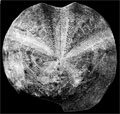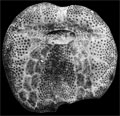The Echinoid Directory
Contributed by Andrew Smith, November 2011
Cagaster Nisiyama, 1968, p. 248
| Diagnostic Features |
|
|---|---|
| Distribution | Miocene, Japan |
| Type | Schizaster recticanalis Yoshiwara, 1899, p. 2, by original designation. |
| Species Included | One other unnamed species was included by Nisiyama (1966) |
| Classification and/or Status | Irregularia, Spatangoida, Paleopneustina, Prenasteridae? Monotypic |
| Remarks | Nisiyama (1968) compared this with Brisaster which also has 3 gonopores, differentiating it on its shallower anterior groove and better developed latero-anal fasciole. It is described as having the peripetalous fasciole passing a short distance below the anterior petals and seems also to have it crossing plate 4 in the anterior interambulacra. This suggests closer affinities with Tripylus, which also has three gonopores. It differs from Tipylus in having shallower petals and a marked difference in the lengths of the anterior and posterior pairs of petals. Nisiyama, S. 1968. The echinoid fauna from Japan and adjacent regions. Part II. Palaeontological Society of Japan Special Papers 13, 1-491, pls 19-30. |


